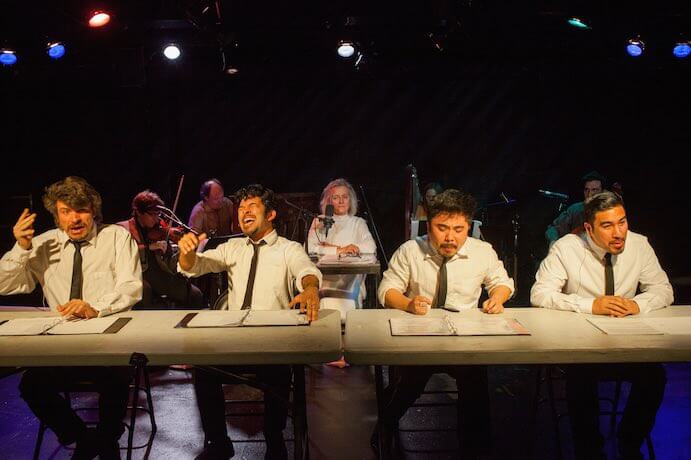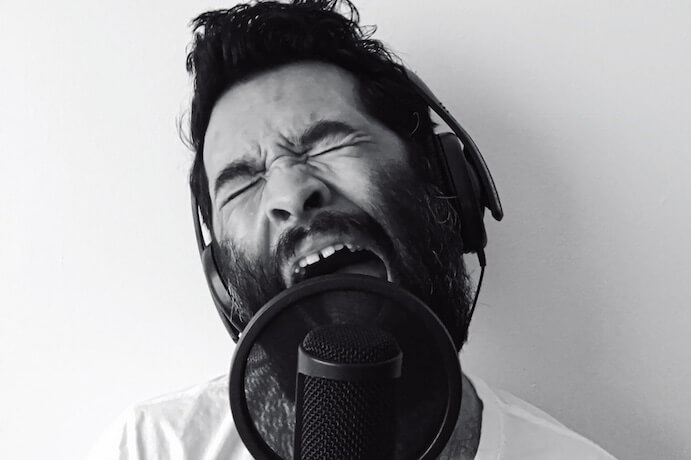Thomas Paine in Violence is one of those experiences that I tell other people about when they ask, “what was one of the most affecting performances you’ve seen in the last few years?” When I saw Paul Pinto and Alejandro Acierto perform tag-team versions of scenes for Omaha Under the Radar in 2015, my mouth fell agape. Even seeing it in this two-person version, I was overwhelmed with how compelling it would be in its eighty-minute opera version starring legendary vocalist Joan La Barbara as Thomas Paine, and scored for nine singers also playing percussion, violin, cello, harp and piano, various foley objects, and live electronics.
Simultaneously set in the mind and afterlife of the revolutionary activist and political philosopher, Thomas Paine in Violence is a new work of opera theater, setting the author of Common Sense in a cosmic radio station, struggling to organize and communicate a message of economic justice amidst a whirlwind of strange figures, audio speakers, microphones and electronic gadgetry orbiting around the space, enveloping the audience in a whirlwind of sound and text. Commissioned by and premiering in HERE’s 2017-2018 season on November 6-18, TPIV is a collaboration between vocalist-composer-wordsmith Paul Pinto (thingNY, Varispeed, Robert Ashley, Natasha, Pierre and the Great Comet of 1812) and director Rick Burkhardt (Here Be Sirens, Three Pianos, Nonsense Company).
After starting as a 15-minute radio opera and growing through three years of development, what have been the major milestones for this project?
The first big milestone was to actually decide that it should be a staged production. The leaders at HERE–Artistic Director Kristin Marting and Producing Director Kim Whitener–were big proponents of a live component. I flirted with the idea of making it album only, or a pirate radio stream, or a sonic installation of some sort, but a lot of factors ultimately led me to just decide on a good old-fashioned proscenium piece of opera-theatre. The greatest of those factors was the addition of the Manchorus, a four-member male chorus. In my eyes, they’re the dynamism and playfulness that balances the beauty and severity of Joan La Barbara’s lilting Thomas Paine. When those guys were added as instigators, agitators and hype men, their gestural and sonic vocabulary became part of the DNA of the opera.
Is it important that audiences already know about Thomas Paine and his contribution to our political history to interact with your opera?
No, it’s not necessary to rely on prior knowledge of Thomas Paine and his writing to enjoy the piece, but… y’know… who doesn’t love spoilers.
Thomas Paine in Violence isn’t a biopic, nor is it a convoluted narrative. It’s a complex barrage of sounds based on a simple premise: Thomas Paine (whoever he might be) is in a radio space and he is a woman and he/she is very upset about things.
We play with Paine’s text, scrambling it up with our own words. Come, listen, get overwhelmed (in a good way) and then later, another night, curl up with Paine and read what he wrote about a universal basic income, about land value and taxation, about activism and abuse of power–he’s an incredible wordsmith.
Already know a bunch about Paine? Paine-ites will get their fill of 19th Century Easter eggs, and can come with highlighted copies of The Rights of Man with bright smiles. Are you more of a “wasn’t-he-a-founding-father” type? You’ll get your fill of pop culture, wordplay, dark humor, Lil’ Jon, Mr. T. and colorful swearing.
There are moments in the piece in which the words seem to move so quickly that it’s past comprehension. Can you talk about how you used text and pacing to create different moods throughout the work?
I hope someone out there shares my experience, but I have never been able to grasp and retain most of most opera, rap, philosophical text, or lecture. So, I’m playing with that by writing my enjoyment at not grasping everything, but enjoying the adventure. There’s meaning in words by their nature, so I play with the purposeful breakdown of that communication by obscuring meaning through censorship, electronic manipulation of the voice, “extended” vocal techniques, and a grueling rate of speech. I would like to think I’m always using words (and their pacing and setting) as both timbral color and poetic communication. Sometimes the sound stage is engulfed in nine people talking over one another, and at other times a single voice takes a minute to sing a six-word sentence. Sometimes the chorus of four are singing unison falsetto at 300 words per minute, and other times they’re looping the same sound bite as their voices are autotuned within an inch of their lives.

Thomas Paine in Violence–Photo by Benjamin Heller
I would describe this work as not unlike the “Hamilton” of chamber opera in being able to reach many different communities of listeners. How do you feel that TPIV reaches out to more diverse audiences in today’s contemporary vocal performance and opera landscape?
Well, I feel just so great about it. I hope it does do that. I’m also conscious that I don’t create work in a bubble. I do the type of opera that I do because Travis Just and Object Collection do the type of work that they do, and Diamanda Galas and Joan La Barbara do the type of work they do, and because Experiments in Opera does the type of work that they do, and Panoply and thingNY do it, and because City Opera and the Met and the Industry and Chamber Made and La Scala and Bayreuth exist. Our community is only made richer by diverse voices, and I mean that in both style and casting– as in: 1) fresh and captivating opera-theatre should actually try to sound different from one another, and 2) presenters have a responsibility to actually bring great black and brown performers to interesting weirdo roles where they don’t just have to be “the black” or “the brown” character. While we’re at it: program more female-created operas, and gender-bend roles, and invest in making queer voices the popular and mainstream theatre voices. Let’s do that. That sounds just great to me.

Joan La Barbara in Thomas Paine in Violence–Photo by Benjamin Heller
We have all heard that opera can be a very elitist art form. Have you ever felt confronted by the notion of using opera as the medium to discuss social inequality?
I may the wrong guy to ask about this. Yeah. I struggle with this, because we are living in a time when some of our countrymen (people like our shithead of a president and his shithead political party) throw “elitism” around because they can use the fear of information, rigor, education, and institutions as a weapon to assert power. And that’s dangerous. Even if elitism is about money and influence, I got news: opera ain’t making anyone rich or powerful. Jazz, hip hop, television, the military, Pokemon, and agriculture all require skill and practice and institutional support, and rake in tons more cash.
Oh, god. Am I defending opera? I have no idea why I’m doing that.
For some reason I think of Wagner, so sure of his role in making opera more populist by taking out all the songs and upping the production value so that it’s bombastic and emotional. My reaction is “sure, that’s a great idea,” but then again, a lot of people find Wagner’s music alienating because he got rid of the songs and made everything expensive and bombastic and emotional. Bob Ashley’s music is such an influence on me, and for me, he’s a creator of such accessible and enjoyable work, but then again, I performed The Wolfman once and cleared the room out. So, who knows.
Oh, god. I’m ranting. Stay focused.
Really, I think any medium can and should stand for something. Good art stands for something and needs to have an urgency for why it was written and why it should keep getting performed, I think. And I think of Paine as my urgent way to express feelings about social inequality. It’s not really a discussion because there’s no back and forth. It’s the emotions surrounding the discussion. The emotions are spilled out and laid naked in art. The emotions are digested and pondered by people in the room. Then, we can go back to the everyday volunteerism, donations, good citizenship, and standing up for good people and good policies, with maybe a renewed vigor and a feeling that, yes, this injustice is fucking crazy, and yes, that’s what crazy sounds like.





















